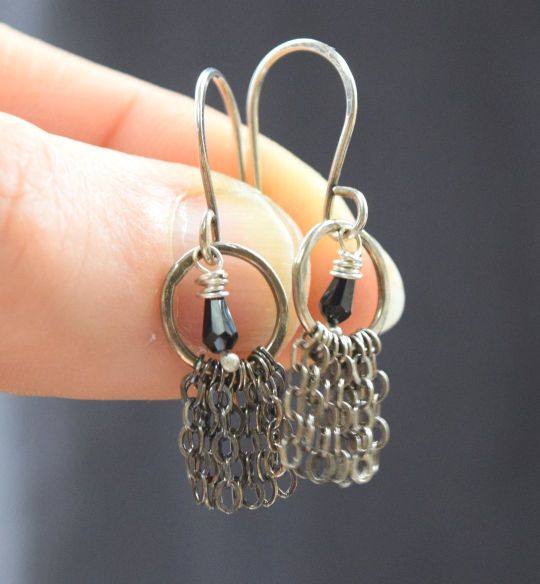#finecrafter
Explore tagged Tumblr posts
Photo

Sleepy Cat Jewelry's shop is updated with two pairs of earrings and a bracelet! The first pair is sterling silver tourmaline dangle earrings with chain tassels and the second is sterling silver post earrings with textured crescent moons and stars. The bracelet is a sweet, simple design with a handcrafted flower at the center with two wirewrapped amethyst beads. The chain fastens with a lobster clasp. Ordering these or something else as a gift? 🎁 If you need them by first night of Hannukah please order no later than Saturday, December 10. If you're ordering for Christmas, you have a little more time, but, please place all orders by December 15. I don't want anyone disappointed that their gifts didn't arrive on time. #sleepycatjewelry #justlisted #earrings #bracelet #sterlingsilverjewelry #OOAKjewelry #OOAKgifts #amethyst #tourmaline #moonandstar #silversmith #metalsmith #opthandmade #shopsmall #NJartist #makersofnj #thebestthingscomeinsmallpackages #finecraft #handcraftedjewelry #holidayshopping #giftforher https://www.instagram.com/p/Cl1gaPpLGAT/?igshid=NGJjMDIxMWI=
#sleepycatjewelry#justlisted#earrings#bracelet#sterlingsilverjewelry#ooakjewelry#ooakgifts#amethyst#tourmaline#moonandstar#silversmith#metalsmith#opthandmade#shopsmall#njartist#makersofnj#thebestthingscomeinsmallpackages#finecraft#handcraftedjewelry#holidayshopping#giftforher
2 notes
·
View notes
Photo

Basement - Transitional Basement Example of a mid-sized transitional underground ceramic tile basement design with white walls
#transitional basement#the urban brick#finecraft contractors inc.#finecraft contractors#bethesda#wet bar
0 notes
Photo

DC Metro Bathroom An undermount sink, recessed-panel cabinets, gray cabinets, granite countertops, a one-piece toilet, and gray walls can be seen in this mid-sized, trendy alcove shower photo. It also has a dark wood floor and gray walls.
#finecraft contractors#stucco#contemporary design#white window trim#contemporary kitchen#open kitchen#open floor plan
0 notes
Photo

Family Room Library DC Metro Mid-sized traditional enclosed family room library idea with pink walls and a media wall. Dark wood floor.
#chandeliers#finecraft contractors inc.#finecraft contractors#library#bethesda#general contractor in bethesda#remodeling in bethesda
0 notes
Photo

Bathroom in DC Metro A medium-sized, modern bathroom with a 3/4-inch dark wood floor and gray walls, recessed-panel cabinets, and granite countertops is shown in the photo.
0 notes
Photo

DC Metro Front Yard Mid-sized eclectic stone front porch idea with a roof extension
#finecraft contractors inc.#vintage pendant lighting#divine dining chandelier#porch#finecraft contractors#front porch
0 notes
Photo

Tile DC Metro An illustration of a medium-sized, modern backyard tile patio with an addition to the roof
0 notes
Photo

Underground - Transitional Basement Example of a mid-sized transitional underground ceramic tile basement design with white walls
#rustic style#basement#transitional design#finecraft contractors#rustic transitional#transitional basement#transitional style
0 notes
Photo

Basement Underground in DC Metro Example of a mid-sized transitional underground ceramic tile and beige floor basement design with white walls
#the urban brick#underground#finecraft contractors inc.#transitional style#remodeling in bethesda#general contractor in bethesda
0 notes
Photo

DC Metro Bathroom An undermount sink, recessed-panel cabinets, gray cabinets, granite countertops, a one-piece toilet, and gray walls can be seen in this mid-sized, trendy alcove shower photo. It also has a dark wood floor and gray walls.
#finecraft contractors#stucco#contemporary design#white window trim#contemporary kitchen#open kitchen#open floor plan
0 notes
Photo

DC Metro Transitional Basement Mid-sized transitional underground ceramic tile basement photo with white walls
0 notes
Photo

Basement Underground in DC Metro Example of a mid-sized transitional underground ceramic tile and beige floor basement design with white walls
#the urban brick#underground#finecraft contractors inc.#transitional style#remodeling in bethesda#general contractor in bethesda
1 note
·
View note
Photo

Bedroom Master Inspiration for a large contemporary master dark wood floor and brown floor bedroom remodel with blue walls and no fireplace
0 notes
Text
#sculpture#woodart#woodartist#woodsculpture#finecraft#artisan#maker#craftsman#designer#designermaker#galleryart#woodworking#woodcraft#finewoodworking#crafts#contemporarycraft#slowcraft#slowmade#slowdesign#folkart#handmademovement#traditionalskills#woodcrafts#woodcarving#uniquestyle
0 notes
Photo








American Privateer...The Progress
At the time of this post I am now working the masts. I duly appreciate the views and following on this subject. Thanks! Although I’m a versatile artist, maritime subjects has always been my ‘go to’ medium...past and present.
The last image of the chicken coop will get the attention of many when it is installed at its home in Philadelphia. More on that later. Thanks again for viewing!
#age of sail#privateer#craftsman#artist#museum#executive director#naval history#mariner#sea history#trending news#nautical#maritime#fineart#finecraft#scalemodel#model ship#scratchbuilt#engineering#innovation#design#custommade#the collector#usa#uk
1 note
·
View note
Photo

#Strands2023 is March 19, 2023, in Atlanta. Come out and support @creattieanndesigns and 13 more fabulous, creative #crochet and #knit designers. Tickets available at fiberartsfashion.com. Follow @fiberartsfashion and the following Strands 2023 fiber artists: @buddha_flywear @yubehandmade @creationsbycourtneyllc @creattieanndesigns @dafynedesigns @flavourcrochet @ishineadornments @kellys_knitch @plushphunk @reneefrancedesigns @crochet_clayborne @tere.crochetwear @rockygetscrafty @pinkjoycrochets #fiberartsfashion #atlanta #yarnart #fiberart #fashion #fineart #finecraft #fashionshow #atlfashion #atlmodels #models #designers https://www.instagram.com/p/CpfjLBBOn3m/?igshid=NGJjMDIxMWI=
#strands2023#crochet#knit#fiberartsfashion#atlanta#yarnart#fiberart#fashion#fineart#finecraft#fashionshow#atlfashion#atlmodels#models#designers
1 note
·
View note